If you are looking for the best formula milk for a 4 month old baby in Malaysia, you’ve come to the right place. Breastmilk is nature’s perfect baby food. But if you can’t breastfeed, or if you’ve chosen not to, formula milk is the next best thing. Scientists and medical experts have spent years developing high-quality formula milks that will provide your baby with the nutrition she needs
When you’re deciding which is the best milk powder for your baby, you will need to take several factors into consideration. Think about her health and dietary needs, her age, and the cost and preparation time of different formula milks.
As a summary, there are three different types of formula:
Best Formula Milk for 4 Month Old in Malaysia
1. Enfalac A+ Step 1 Milk Formula Powder | Check on Lazada / Check on Shopee
2. Similac Lactose Free | Lactose Free Formula | Check on Lazada / Check on Shopee
When you’re deciding which is the best milk powder for your baby, you will need to take several factors into consideration. Think about her health and dietary needs, her age, and the cost and preparation time of different formula milks.
As a summary, there are three different types of formula:
- cow’s milk-based formula
- hydrolysed protein formula
- soya-based formula
Best Formula Milk for 4 Month Old in Malaysia
1. Enfalac A+ Step 1 Milk Formula Powder | Check on Lazada / Check on Shopee
2. Similac Lactose Free | Lactose Free Formula | Check on Lazada / Check on Shopee
3. Wyeth S26 SMA Susu Bayi 0-12Month | Check on Lazada / Check on Shopee
4. Anmum Infacare Step 1 | Check on Lazada / Check on Shopee
5. Similac Step 1 Milk Formula | Check on Lazada / Check on Shopee
6. Nan Pro Step 1 | Check on Lazada / Check on Shopee
7. Dumex Mamex Step 1 Baby Formula | Check on Lazada / Check on Shopee
8. Nestle Nan HA 1 Milk Powder | Half Hydrolyzed Protein | Check on Lazada / Check on Shopee
9. Novalac Novarice Infant Formula | Formula Based on Rice Protein | Check on Lazada / Check on Shopee
10. Bellamy’s Organic Formula Step 1 | Check on Lazada / Check on Shopee
1. Enfalac A+ Step 1 Milk Formula Powder (2.4kg)
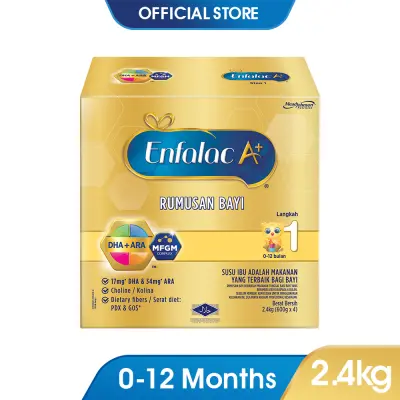
– Contains:17mg DHA & 34mg ARAPDX* & GOS
– DHA & ARA are important building blocks for brain and eye development
– Choline: supports overall mental and physical development.
– A unique blend of PDX (Polydextrose) and GOS. Prebiotic (GOS) stimulates the growth of beneficial intestinal flora to maintain a healthy digestive system.
– Zinc & Iron: support your child’s natural defenses
Similac Lactose Free is a cow’s milk-based lactose free formula suitable for infants with lactose intolerance. It is enriched with important vitamins and minerals needed for your child’s development, you can be rest assured that your child will be getting all the necessary nutrients he or she needs in order to grow!
Ingredients: Cow’s milk-based lactose free formula (with DHA, Lutien and Vitamin E).
4. Anmumlac Infacare Step 1 Infant Milk Formula (900g)
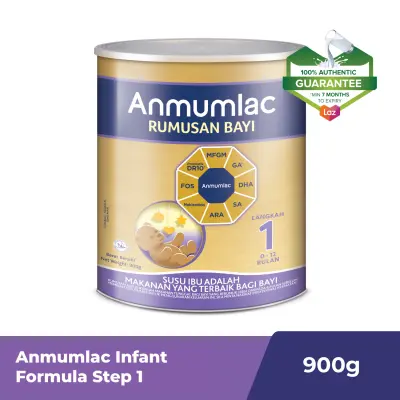
Anmumlac Infant Formula Step 1 is formulated for newborn babies up to 12 months for their growth and development. This formulation contains MFGM, including GA. Also contains Nucleotides, Calcium, Zinc, Vitamin A, C, D3, Iron, Iodine, Probiotic, Bifidobacterium Lactis (DR10*) and dietary fibre FOS.
MFGM (Milk Fat Globule Membrane)
GA* (Gangliosides)
DHA (Docosahexaenoic Acid)
Sialic Acid (Important component of brain tissue)
Arachidonic Acid
Nucleotides
FOS (FructoOligosaccharides)
Probiotic Bifidobacterium Lactis DR10*
(Helps improve a beneficial intestinal microflora)
(Helps to reduce the incidence of diarrhoea.)
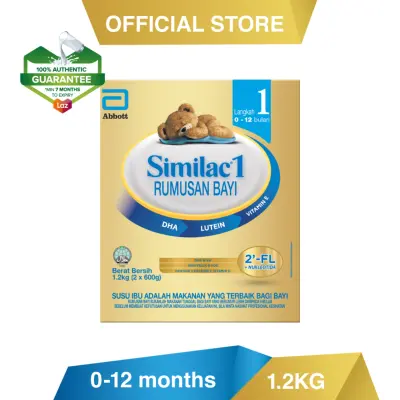
Similac Gold is now with 2’-FL to enable your child to not only grow stronger but also build a good body defense system. With a stronger body defense, your child is able to learn fearlessly and faster with Eye-Q system which contains Unique Vegetable Oil Blend
– For better DHA absorption, Lutein and Natural Vitamin E
– To protect DHA from oxidation and a combination of nutrients – which enable more brain cell connections.
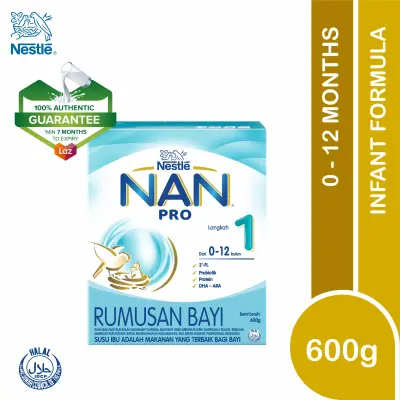
• NAN PROS 1 is a premium infant formula that is scientifically formulated with Probiotics, 2′-FL Oligosaccharide, Protein, DHA & ARA.
• 2′-FL Oligosaccharide is a carbohydrate that is derived from lactose using a fermentation process.
• Studies show that 2′-FL Oligosaccharide increases beneficial bacteria in the gut, strengthens the gut barrier function and removes harmful bacteria in the gut.
CHECK ON LAZADA || CHECK ON SHOPEE
7. Dumex Mamex Step 1 Baby Formula (600g)

– DHA, AA, Vitamin A,C,D,E, Protein, Calcium, Zinc, Iron, Idine.
– Oligosaccharide Mixture containing 90%, GOS (0.72g/100ml) and 10% IcFOS (0.08g/700ml) helps to improve the intestinal bifidobacterial and helps maintain a good intestinal environment.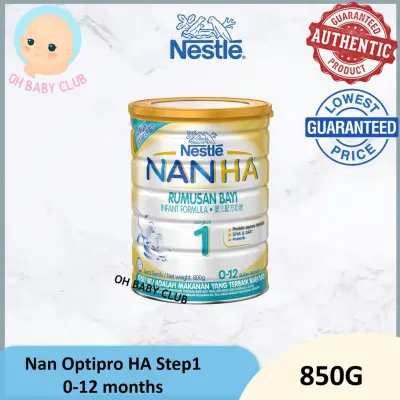
NAN H.A.® 1 is an infant formula. Recommended for infants likely to be at risk of developing an allergy (e.g. another member of the family is allergic). The taste of the milk may be slightly different due to the hydrolysis process. However, this taste is easily accepted by babies.
• Added with Nucleotides
• Bifidobacterium lactis helps improve a beneficial intestinal microflora
• Bifidobacterium lactis may help to reduce the incidence of diarrhoea
• Added with long chain polyunsaturated fatty acids – Docosahexaenoic Acid (DHA) and Arachidonic Acid (ARA)
CHECK ON LAZADA || CHECK ON SHOPEE
9. Novalac Novarice Infant Formula (800g)
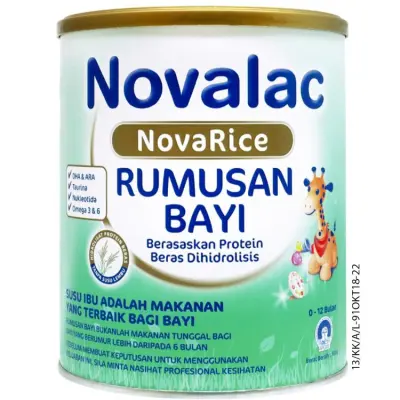
Novarice is a special formula based on rice proteins that is nutritionally complete and suitable for infants who are suffering from food allergies like cow’s milk protein or soya. Novarice also suits infants with lactose intolerance or any protein malabsorption.
– Lactose-Free
– DHA & ARA
– 5 nucleotides
– Essential Fatty Acid
– Linolenic acid and linoleic acid
– Vitamin A, D, E, K, C, B complex, Biotin, Niacin, Folic Acid, Pantothenic Acid
– Sodium, Potassium, Chloride, Calcium, Phosphorus, Magnesium, Iron, Zinc, Iodine, Copper, Manganese, Selenium
– Contains Choline, Inositol, L-carnitine, Taurine
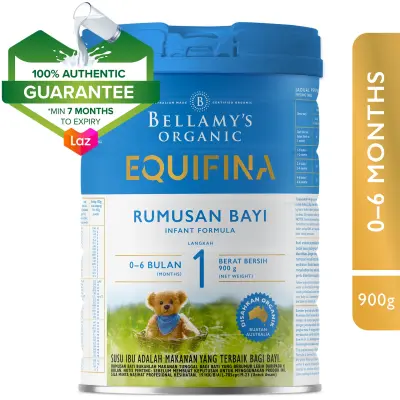
Bellamy’s Organic Step 1 Infant Formula is suitable for most babies from birth through to 12 months. It’s made from certified organic cows milk, blended with essential fatty acids, vitamins and minerals so you can be sure you are offering your baby the best nutrition in accordance with world-class Australian Food guidelines and standards.
Our Infant Formula is whey dominant which means that it is easy for babies to digest and perfectly balanced to provide your baby’s nutritional needs.
Warning: Contains milk and soybean products.
0-6 months - Stage 1
Newborns should either breast milk or infant formula on demand.
Breast Milk
For new-born babies, WHO advices to solely breastfeed for the first 6 months and then continue with additional nutritious foods up to 2 years old, based on you and your baby’s needs. (Source)
Breastfeeding is usually the better option compared to formula milk because it..
– Adapts to the baby’s changing requirements
– Provides babies with all of the vital nutrition and hydration they need
– Helps protect against infection and to build a healthy immune system
– Is a cheap and convenient to feed your babies wherever and whenever they need to.
Infant Formula Milk
In case breastfeeding doesn’t work or you choose not to breastfeed, infant formula is the only suitable alternative. It should be your baby’s only source of nutrition for the first 6 months. A formula-fed infant will drink every 3 – 4 hours and will increase as your baby grows.
According to NHS guidelines, cow’s milk and other substitutes should not be introduced as a main drink until after 1 year. Never start solids before 4 months. Source
Always seek medical advice before buying infant formula.
Here are some infant milk formulas you can get in Malaysia..
– Enfalac A+ Step 1 (2.4 kg): RM278 > Lazada
– Similac Step 1 (1.2 kg), RM116 > Lazada
– Nestle NAN Pro Step 1 (600g), RM76.36 > Lazada
– Anmum Infacare Step 1 (650g), RM67 > Lazada
Water – NOT Recommended
[Source]
It is recommended that you do not give babies under six months of age water. Until your little one is six months they should receive only breastmilk or formula.
Here are some of the common consequences of introducing water to babies too early..
– Lack of nutrients from milk or formula
– Slower weight gain and decreased development
– Weaker immunity
– Potential of reduced breast milk supply
– Water intoxication
For more information, check out When Can Babies Drink Water
4-6 Months Old
Most babies are ready to start solids around 5 – 6 months old.
Some signs that show they are ready include..
– Mastering the grabbing skill
– Developing head and neck control
– Losing the tongue-thrust mechanism that automatically pushes food out of their mouth. N
Aim to feed about 1-2 tablespoons of food twice a day to your baby. Solid food shouldn’t replace milk as the main source of nutrients.
6-12 months - Stage 2
At 6 months, parents will usually introduce more foods into their baby’s diet, so the amount of milk they will need will gradually decrease. For both formula-fed and breastfed babies, the amount of milk they drink should naturally adjust according to how much food they have eaten.
However, for babies 6 to 9 months old, most of their calories should still come from breast milk or formula. Don’t stress about getting them to eat bite after bite of solid food. Feed up to two meals daily (or once every couple of days for some babies), with each meal 2 to 4 tablespoons.
Suitable baby foods include iron-fortified single-grain baby cereal along with pureed vegetables, fruits, and meats. You can also try offering finger foods like cut vegetables, fruit, yogurt and cheese. However, try not to introduce more than one food at a time to identify possible allergies or digestive problems.
Water can be introduced in small amounts with meals. It is generally advised not to give your baby more than 100ml to 150ml a day. As they age, you may start introducing more water with the help of sippy cups and straws.
For a more detailed guide on introducing water to your baby, do check out When Can Babies Drink Water .
If they seem to have an endless appetite or don’t seem to be eating enough, contact your child specialist.
9-12 Months Old
At this age, about half of your baby’s calories may usually come from food and the other half from breast milk or formula.
Babies these age are usually interested in trying new foods, so you can try to give them small pieces of your own meals. If they want more, give them more, but if they push it away, maybe that item is just not their one of their favourites.
Babies like to play with their food, so you can try using yogurt, cheese or oats as a sauce for vegetables or whole-grain crackers. Just remember to cut the foods properly and to avoid hard pieces to prevent choking.
12 months onwards - Stage 3
Summary : Feed breast milk, dairy milk (cow / goat / etc), alternative plant based milk (soy), more soft / semi solid foods. Seek medical advice before feeding non breast milk alternatives.
Children will usually start to eat larger, more regular meals and get most of their nutrition from foods other than milk. WHO recommends that babies continue to be breast fed up to 2 years and beyond, but they may begin to need less breast milk as they eat more food.
After 12 months, your baby may not need formula milk anymore as they can start drinking cow’s milk and other alternatives more regularly.
Below are some of the main types of milk that may be given at this stage.
Cow’s Milk – For children under 2, choose full-fat cow’s milk. Semi-skimmed doesn’t have the same nutrient profile in terms of vitamins and minerals and has less energy.
Goat’s / Sheep’s Milk – Their nutrient profiles are similar to cow’s milk so as long as they’re pasteurised, they’re alright to offer.
Soya Drinks & Other Milk Alternatives – As part of a healthy, balanced diet, soya, oat, almond and other vegetable based milks can be offered or used in cooking. However, they are usually not as nutritionally comparable to cow’s milk. Furthermore, not all brands fortify with the same nutrients.
2 years and above
Summary : Feed cow’s milk or alternative, and a balanced diet. Formula milk as an addition if the child is not receiving enough nutrients.
Children will start to eat a more varied, balanced diet and may rely less on milk. You may adjust how much milk you give them based on their diet throughout the week. If your child’s diet doesn’t include dairy, you should consider how you can replace any nutrients they might be missing out on, such as formula milk or alternative foods.
Sources
https://www.srnutrition.co.uk/2019/08/milk-recommendations-for-infants-toddlers/
https://www.aptaclub.de/en/baby/which-milk-should-i-use-and-when.html
https://www.who.int/nutrition/topics/infantfeeding_recommendation/en/
https://www.nhs.uk/conditions/baby/weaning-and-feeding/drinks-and-cups-for-babies-and-young-children/
FAQ
1. How Do I Know If My Baby Has A Milk Allergy?
If your baby shows the following symptoms, do see your pediatrician to check if your baby has a milk allergy.
– Frequent spitting up
– Vomiting
– Signs of abdominal pain, or colic-like symptoms, such as excessive crying and irritability (especially after feedings)
– Diarrhea
– Blood in stool
– Hives
– A scaly skin rash
– Coughing or wheezing
– Watery eyes and stuffy nose
– Trouble breathing or a bluish skin color
– Swelling (especially of the mouth and throat)
2. Milk Allergy vs Lactose Intolerance
For milk allergies, the baby’s immune system reacts negatively to the proteins in cow’s milk. Breastfed babies are reacting to the dairy his mother has eaten (the milk proteins pass through breast milk), while formula-fed babies are reacting to the cow’s milk proteins in the formula. In either case, a baby’s immune system sees the cow’s milk proteins as foreign substances.
Milk intolerance, on the other hand, has nothing to do with cow’s milk proteins or the immune system, and instead has to do with the digestive system. Your child might have loose stools or blood in stool hours or days later.
3. How do I stop my baby from vomiting after feeding?
– Avoid overfeeding. If the baby’s stomach is too full, some of the contents might be pushed back out. To reduce overfeeding, feed your baby smaller amounts more frequently.
– Burp your baby frequently. Extra gas in the stomach causes gas bubbles to escape, which has a tendency to bring the rest of the stomach’s contents up as well. Burp after and during meals.
– Limit active play after meals
– Hold your baby upright. Pressing on a baby’s belly right after feeding may push their stomach contents out.
– Consider the formula. Frequent vomiting may serve as one of several signs that it’s time to consider alternative formulas with your pediatrician.
– Give oatmeal. Only recommended for babies after 6 months old. Babies with reflux may need thicker food to order to swallow safely or reduce reflux.
4. What to do after baby throws up?
– Rest their stomach. Keep your baby from eating or drinking for 30 to 60 minutes after vomiting so that their stomach has time to recover.
– Give them fluids. after 3o minutes, start by giving your baby small amounts (0.5 oz or less) of fluid every 5 to 10 minutes. If your baby vomits the fluid out, wait another 30 minutes. Then start again with small amounts of fluid every 5 to 10 minutes. Use water, breast milk or a clear, noncarbonated liquid.
– Medicines. If your child has a fever, ask your pediatrician for the appropriate medication.
5. How can I treat my baby's reflux naturally?
– Avoid overfeeding. If the baby’s stomach is too full, some of the contents might be pushed back out. To reduce overfeeding, feed your baby smaller amounts more frequently.
– Burp your baby frequently. Extra gas in the stomach causes gas bubbles to escape, which has a tendency to bring the rest of the stomach’s contents up as well. Burp after and during meals.
– Limit active play after meals
– Hold your baby upright. Pressing on a baby’s belly right after feeding may push their stomach contents out.
– Consider the formula. Frequent vomiting may serve as one of several signs that it’s time to consider alternative formulas with your pediatrician.
– Give oatmeal. Only recommended for babies after 6 months old. Babies with reflux may need thicker food to order to swallow safely or reduce reflux.
– Avoid tight diapers or clothing
4. Anmum Infacare Step 1 | Check on Lazada / Check on Shopee
5. Similac Step 1 Milk Formula | Check on Lazada / Check on Shopee
6. Nan Pro Step 1 | Check on Lazada / Check on Shopee
7. Dumex Mamex Step 1 Baby Formula | Check on Lazada / Check on Shopee
8. Nestle Nan HA 1 Milk Powder | Half Hydrolyzed Protein | Check on Lazada / Check on Shopee
9. Novalac Novarice Infant Formula | Formula Based on Rice Protein | Check on Lazada / Check on Shopee
10. Bellamy’s Organic Formula Step 1 | Check on Lazada / Check on Shopee
1. Enfalac A+ Step 1 Milk Formula Powder (2.4kg)

– Contains:17mg DHA & 34mg ARAPDX* & GOS
– DHA & ARA are important building blocks for brain and eye development
– Choline: supports overall mental and physical development.
– A unique blend of PDX (Polydextrose) and GOS. Prebiotic (GOS) stimulates the growth of beneficial intestinal flora to maintain a healthy digestive system.
– Zinc & Iron: support your child’s natural defenses

Similac Lactose Free is a cow’s milk-based lactose free formula suitable for infants with lactose intolerance. It is enriched with important vitamins and minerals needed for your child’s development, you can be rest assured that your child will be getting all the necessary nutrients he or she needs in order to grow!
Ingredients: Cow’s milk-based lactose free formula (with DHA, Lutien and Vitamin E).
CHECK ON LAZADA || CHECK ON SHOPEE
3. Wyeth S26 SMA Susu Bayi 0-12Month (1.2kg)
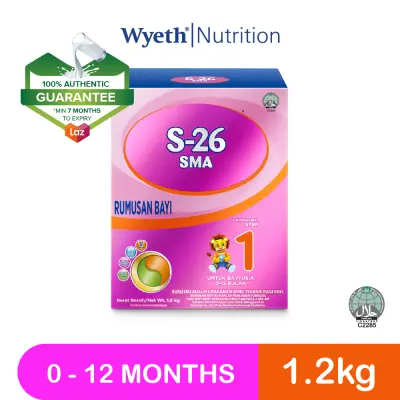
S26 SMA infant formula is formulated for infants from birth until 12 months old. S26 SMA infant formula contains a combination of all the following nutrients:
– AA (97mg/100g) & DHA (56mg/100g): From single cell source
– Lutein:As a predominant macular pigment in the retina, it is able to filter blue light and may protect the eye.
– Iron: A factor in red blood cell formation.
– Zinc: Essential for growth.
– Calcium: Aids in the development of strong bones and teeth.
– Vitamin D: Necessary for the absorption and utilization of calcium and phosphorus.
3. Wyeth S26 SMA Susu Bayi 0-12Month (1.2kg)

S26 SMA infant formula is formulated for infants from birth until 12 months old. S26 SMA infant formula contains a combination of all the following nutrients:
– AA (97mg/100g) & DHA (56mg/100g): From single cell source
– Lutein:As a predominant macular pigment in the retina, it is able to filter blue light and may protect the eye.
– Iron: A factor in red blood cell formation.
– Zinc: Essential for growth.
– Calcium: Aids in the development of strong bones and teeth.
– Vitamin D: Necessary for the absorption and utilization of calcium and phosphorus.
4. Anmumlac Infacare Step 1 Infant Milk Formula (900g)

Anmumlac Infant Formula Step 1 is formulated for newborn babies up to 12 months for their growth and development. This formulation contains MFGM, including GA. Also contains Nucleotides, Calcium, Zinc, Vitamin A, C, D3, Iron, Iodine, Probiotic, Bifidobacterium Lactis (DR10*) and dietary fibre FOS.
MFGM (Milk Fat Globule Membrane)
GA* (Gangliosides)
DHA (Docosahexaenoic Acid)
Sialic Acid (Important component of brain tissue)
Arachidonic Acid
Nucleotides
FOS (FructoOligosaccharides)
Probiotic Bifidobacterium Lactis DR10*
(Helps improve a beneficial intestinal microflora)
(Helps to reduce the incidence of diarrhoea.)

Similac Gold is now with 2’-FL to enable your child to not only grow stronger but also build a good body defense system. With a stronger body defense, your child is able to learn fearlessly and faster with Eye-Q system which contains Unique Vegetable Oil Blend
– For better DHA absorption, Lutein and Natural Vitamin E
– To protect DHA from oxidation and a combination of nutrients – which enable more brain cell connections.

• NAN PROS 1 is a premium infant formula that is scientifically formulated with Probiotics, 2′-FL Oligosaccharide, Protein, DHA & ARA.
• 2′-FL Oligosaccharide is a carbohydrate that is derived from lactose using a fermentation process.
• Studies show that 2′-FL Oligosaccharide increases beneficial bacteria in the gut, strengthens the gut barrier function and removes harmful bacteria in the gut.
CHECK ON LAZADA || CHECK ON SHOPEE
7. Dumex Mamex Step 1 Baby Formula (600g)

– DHA, AA, Vitamin A,C,D,E, Protein, Calcium, Zinc, Iron, Idine.
– Oligosaccharide Mixture containing 90%, GOS (0.72g/100ml) and 10% IcFOS (0.08g/700ml) helps to improve the intestinal bifidobacterial and helps maintain a good intestinal environment.

NAN H.A.® 1 is an infant formula. Recommended for infants likely to be at risk of developing an allergy (e.g. another member of the family is allergic). The taste of the milk may be slightly different due to the hydrolysis process. However, this taste is easily accepted by babies.
• Added with Nucleotides
• Bifidobacterium lactis helps improve a beneficial intestinal microflora
• Bifidobacterium lactis may help to reduce the incidence of diarrhoea
• Added with long chain polyunsaturated fatty acids – Docosahexaenoic Acid (DHA) and Arachidonic Acid (ARA)
CHECK ON LAZADA || CHECK ON SHOPEE
9. Novalac Novarice Infant Formula (800g)

Novarice is a special formula based on rice proteins that is nutritionally complete and suitable for infants who are suffering from food allergies like cow’s milk protein or soya. Novarice also suits infants with lactose intolerance or any protein malabsorption.
– Lactose-Free
– DHA & ARA
– 5 nucleotides
– Essential Fatty Acid
– Linolenic acid and linoleic acid
– Vitamin A, D, E, K, C, B complex, Biotin, Niacin, Folic Acid, Pantothenic Acid
– Sodium, Potassium, Chloride, Calcium, Phosphorus, Magnesium, Iron, Zinc, Iodine, Copper, Manganese, Selenium
– Contains Choline, Inositol, L-carnitine, Taurine

Bellamy’s Organic Step 1 Infant Formula is suitable for most babies from birth through to 12 months. It’s made from certified organic cows milk, blended with essential fatty acids, vitamins and minerals so you can be sure you are offering your baby the best nutrition in accordance with world-class Australian Food guidelines and standards.
Our Infant Formula is whey dominant which means that it is easy for babies to digest and perfectly balanced to provide your baby’s nutritional needs.
Warning: Contains milk and soybean products.
0-6 months - Stage 1
Newborns should either breast milk or infant formula on demand.
Breast Milk
For new-born babies, WHO advices to solely breastfeed for the first 6 months and then continue with additional nutritious foods up to 2 years old, based on you and your baby’s needs. (Source)
Breastfeeding is usually the better option compared to formula milk because it..
– Adapts to the baby’s changing requirements
– Provides babies with all of the vital nutrition and hydration they need
– Helps protect against infection and to build a healthy immune system
– Is a cheap and convenient to feed your babies wherever and whenever they need to.
Infant Formula Milk
In case breastfeeding doesn’t work or you choose not to breastfeed, infant formula is the only suitable alternative. It should be your baby’s only source of nutrition for the first 6 months. A formula-fed infant will drink every 3 – 4 hours and will increase as your baby grows.
According to NHS guidelines, cow’s milk and other substitutes should not be introduced as a main drink until after 1 year. Never start solids before 4 months. Source
Always seek medical advice before buying infant formula.
Here are some infant milk formulas you can get in Malaysia..
– Enfalac A+ Step 1 (2.4 kg): RM278 > Lazada
– Similac Step 1 (1.2 kg), RM116 > Lazada
– Nestle NAN Pro Step 1 (600g), RM76.36 > Lazada
– Anmum Infacare Step 1 (650g), RM67 > Lazada
Water – NOT Recommended
[Source]
It is recommended that you do not give babies under six months of age water. Until your little one is six months they should receive only breastmilk or formula.
Here are some of the common consequences of introducing water to babies too early..
– Lack of nutrients from milk or formula
– Slower weight gain and decreased development
– Weaker immunity
– Potential of reduced breast milk supply
– Water intoxication
For more information, check out When Can Babies Drink Water
4-6 Months Old
Most babies are ready to start solids around 5 – 6 months old.
Some signs that show they are ready include..
– Mastering the grabbing skill
– Developing head and neck control
– Losing the tongue-thrust mechanism that automatically pushes food out of their mouth. N
Aim to feed about 1-2 tablespoons of food twice a day to your baby. Solid food shouldn’t replace milk as the main source of nutrients.
6-12 months - Stage 2
At 6 months, parents will usually introduce more foods into their baby’s diet, so the amount of milk they will need will gradually decrease. For both formula-fed and breastfed babies, the amount of milk they drink should naturally adjust according to how much food they have eaten.
However, for babies 6 to 9 months old, most of their calories should still come from breast milk or formula. Don’t stress about getting them to eat bite after bite of solid food. Feed up to two meals daily (or once every couple of days for some babies), with each meal 2 to 4 tablespoons.
Suitable baby foods include iron-fortified single-grain baby cereal along with pureed vegetables, fruits, and meats. You can also try offering finger foods like cut vegetables, fruit, yogurt and cheese. However, try not to introduce more than one food at a time to identify possible allergies or digestive problems.
Water can be introduced in small amounts with meals. It is generally advised not to give your baby more than 100ml to 150ml a day. As they age, you may start introducing more water with the help of sippy cups and straws.
For a more detailed guide on introducing water to your baby, do check out When Can Babies Drink Water .
If they seem to have an endless appetite or don’t seem to be eating enough, contact your child specialist.
9-12 Months Old
At this age, about half of your baby’s calories may usually come from food and the other half from breast milk or formula.
Babies these age are usually interested in trying new foods, so you can try to give them small pieces of your own meals. If they want more, give them more, but if they push it away, maybe that item is just not their one of their favourites.
Babies like to play with their food, so you can try using yogurt, cheese or oats as a sauce for vegetables or whole-grain crackers. Just remember to cut the foods properly and to avoid hard pieces to prevent choking.
12 months onwards - Stage 3
Summary : Feed breast milk, dairy milk (cow / goat / etc), alternative plant based milk (soy), more soft / semi solid foods. Seek medical advice before feeding non breast milk alternatives.
Children will usually start to eat larger, more regular meals and get most of their nutrition from foods other than milk. WHO recommends that babies continue to be breast fed up to 2 years and beyond, but they may begin to need less breast milk as they eat more food.
After 12 months, your baby may not need formula milk anymore as they can start drinking cow’s milk and other alternatives more regularly.
Below are some of the main types of milk that may be given at this stage.
Cow’s Milk – For children under 2, choose full-fat cow’s milk. Semi-skimmed doesn’t have the same nutrient profile in terms of vitamins and minerals and has less energy.
Goat’s / Sheep’s Milk – Their nutrient profiles are similar to cow’s milk so as long as they’re pasteurised, they’re alright to offer.
Soya Drinks & Other Milk Alternatives – As part of a healthy, balanced diet, soya, oat, almond and other vegetable based milks can be offered or used in cooking. However, they are usually not as nutritionally comparable to cow’s milk. Furthermore, not all brands fortify with the same nutrients.
2 years and above
Summary : Feed cow’s milk or alternative, and a balanced diet. Formula milk as an addition if the child is not receiving enough nutrients.
Children will start to eat a more varied, balanced diet and may rely less on milk. You may adjust how much milk you give them based on their diet throughout the week. If your child’s diet doesn’t include dairy, you should consider how you can replace any nutrients they might be missing out on, such as formula milk or alternative foods.
Sources
https://www.srnutrition.co.uk/2019/08/milk-recommendations-for-infants-toddlers/
https://www.aptaclub.de/en/baby/which-milk-should-i-use-and-when.html
https://www.who.int/nutrition/topics/infantfeeding_recommendation/en/
https://www.nhs.uk/conditions/baby/weaning-and-feeding/drinks-and-cups-for-babies-and-young-children/
FAQ
1. How Do I Know If My Baby Has A Milk Allergy?
If your baby shows the following symptoms, do see your pediatrician to check if your baby has a milk allergy.
– Frequent spitting up
– Vomiting
– Signs of abdominal pain, or colic-like symptoms, such as excessive crying and irritability (especially after feedings)
– Diarrhea
– Blood in stool
– Hives
– A scaly skin rash
– Coughing or wheezing
– Watery eyes and stuffy nose
– Trouble breathing or a bluish skin color
– Swelling (especially of the mouth and throat)
2. Milk Allergy vs Lactose Intolerance
For milk allergies, the baby’s immune system reacts negatively to the proteins in cow’s milk. Breastfed babies are reacting to the dairy his mother has eaten (the milk proteins pass through breast milk), while formula-fed babies are reacting to the cow’s milk proteins in the formula. In either case, a baby’s immune system sees the cow’s milk proteins as foreign substances.
Milk intolerance, on the other hand, has nothing to do with cow’s milk proteins or the immune system, and instead has to do with the digestive system. Your child might have loose stools or blood in stool hours or days later.
3. How do I stop my baby from vomiting after feeding?
– Avoid overfeeding. If the baby’s stomach is too full, some of the contents might be pushed back out. To reduce overfeeding, feed your baby smaller amounts more frequently.
– Burp your baby frequently. Extra gas in the stomach causes gas bubbles to escape, which has a tendency to bring the rest of the stomach’s contents up as well. Burp after and during meals.
– Limit active play after meals
– Hold your baby upright. Pressing on a baby’s belly right after feeding may push their stomach contents out.
– Consider the formula. Frequent vomiting may serve as one of several signs that it’s time to consider alternative formulas with your pediatrician.
– Give oatmeal. Only recommended for babies after 6 months old. Babies with reflux may need thicker food to order to swallow safely or reduce reflux.
4. What to do after baby throws up?
– Rest their stomach. Keep your baby from eating or drinking for 30 to 60 minutes after vomiting so that their stomach has time to recover.
– Give them fluids. after 3o minutes, start by giving your baby small amounts (0.5 oz or less) of fluid every 5 to 10 minutes. If your baby vomits the fluid out, wait another 30 minutes. Then start again with small amounts of fluid every 5 to 10 minutes. Use water, breast milk or a clear, noncarbonated liquid.
– Medicines. If your child has a fever, ask your pediatrician for the appropriate medication.
5. How can I treat my baby's reflux naturally?
– Avoid overfeeding. If the baby’s stomach is too full, some of the contents might be pushed back out. To reduce overfeeding, feed your baby smaller amounts more frequently.
– Burp your baby frequently. Extra gas in the stomach causes gas bubbles to escape, which has a tendency to bring the rest of the stomach’s contents up as well. Burp after and during meals.
– Limit active play after meals
– Hold your baby upright. Pressing on a baby’s belly right after feeding may push their stomach contents out.
– Consider the formula. Frequent vomiting may serve as one of several signs that it’s time to consider alternative formulas with your pediatrician.
– Give oatmeal. Only recommended for babies after 6 months old. Babies with reflux may need thicker food to order to swallow safely or reduce reflux.
– Avoid tight diapers or clothing
Related:
Comments
Post a Comment